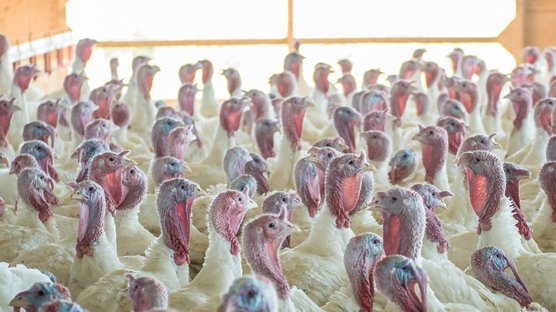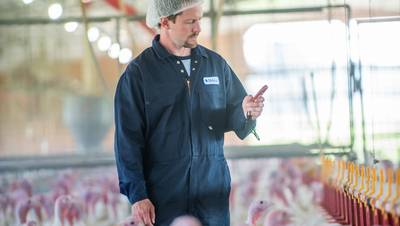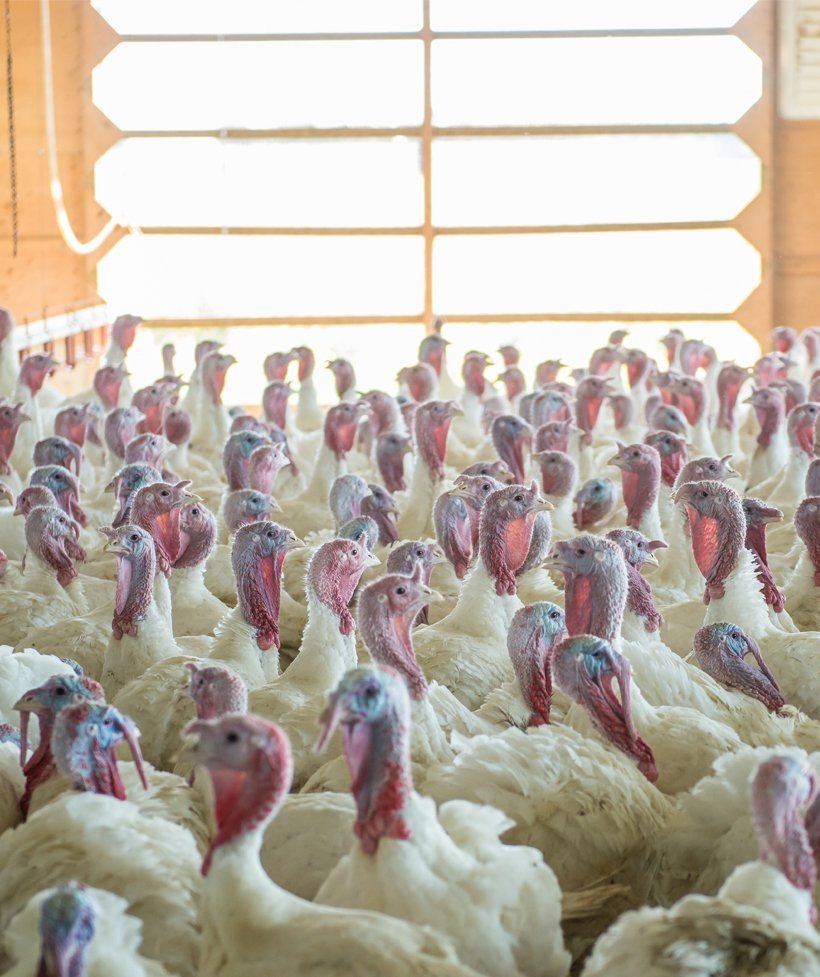
Published on May 25, 2022
Tunnel Ventilation: Ventilating With a Purpose
When the temperatures outside are on the rise, it is important to keep the barn temperature comfortable and consistent, especially during periods of intense heat. Tunnel ventilation has 3 primary functions that help accomplish this task: remove of heat from the barn, decrease heat from the birds and reduce the temperature of incoming air.
Creating the right comfort zone
Very warm conditions can quickly increase the body temperature for birds of all ages and negatively affect activity, as well as impact feed and water consumption. It is important to map out the barn’s air speed to understand the effect it is having on birds of different ages at each level of ventilation.
The primary goal of tunnel ventilation is to keep the birds comfort level as close to ideal as possible. This is known as the “Thermal Neutral Zone” which is estimated to be between 55°and 75°F (13°C and 24°C). This is where the bird does not need to alter its basic metabolic rate to maintain its body temperature. This information is based on birds that are fully feathered and developed. Younger birds can benefit from tunnel ventilation but at slower air speeds depending on the age of the birds. The table below outlines various temperature ranges and resulting impacts to bird performance.
Heat Stress & Ambient Temperature Zones
| Range | Details |
|---|---|
|
55°F to 75°F (13°C to 24°C) |
Thermal neutral zone. The temperature range in which the birds do not need to alter their basic metabolic rate or behaviour to maintain body temperature. |
|
65° F to 75°F (18°C to 24°C) |
Ideal temperature range. |
|
75°F to 85°F (24°C to 29°C) |
A slight reduction in feed consumption can be expected, but if nutrient intake is adequate, production efficiency is good. Egg size may be reduced and shell quality may suffer as temperatures reach the top of this range. |
|
85°F to 90°F (29°C to 32°C) |
Feed consumption falls further. Weight gains are lower. Egg and shell quality deteriorate. Egg production usually suffers. Cooling precedures should be started before this temperature range is reached. |
|
90°F to 95°F (32°C to 35°C) |
Feed consumption continues to drop. There is some danger to heat prostration among breeders, especially the heavier birds and those in full production. At these temperatures, cooling procedures must be carried out. |
Managing Airspeed
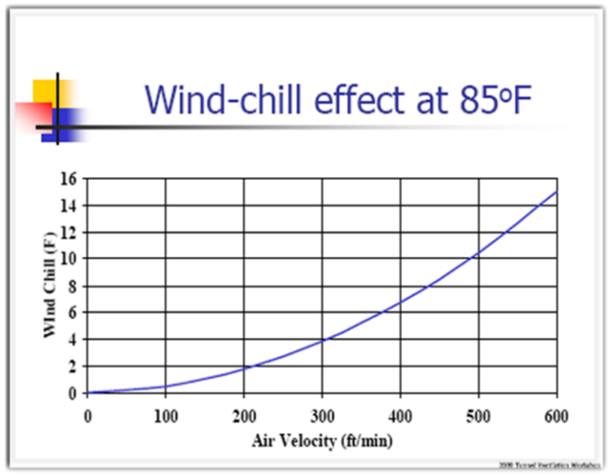
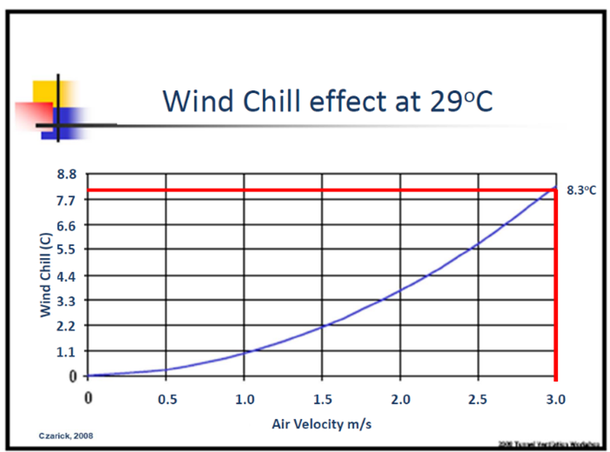
The chart above shows the effect that wind speed has on mature turkeys based on an average temperature of 85°F or 29°C.
A key factor for ventilating turkey barns during hot weather is managing airspeed. As you can see in the example graphs above as the air velocity, also known as air speed, increases so does the windchill effect.
As birds grow into the mature stage of development, managing ‘real feel’ or effective temperatures becomes increasingly important. Effective temperatures are calculated by taking the actual temperature minus the windchill effect. Understanding air speed and its relation to windchill are important when calculating the desired effective temperatures and will help you to understand how many fans are required to achieve your desired windchill. The charts below outline examples of various air speed requirements to achieve different wind chill effects. For example, with an airspeed of 675 ft. per minute (3.4 m/s) at 85°F (29°C), the result is a 15°F (8.3°C) reduction in the ‘real feel’ to the birds. This puts the birds in the ideal range of 65-70°F (18-20°C).
Imperial Chart
| Number of fans | Fan set temperatures | Wind chill effect |
Effective temperatures ‘real feel’ |
Air Speed |
|---|---|---|---|---|
| 54” tunnel fans | Fans ON | Fans OFF | at 85°F | When fans ON | When fans OFF | Approximate in feet/min |
| 4 | 68 | 66 | 1 | 67 | 65 | 150 |
| 6 | 70 | 69 | 3 | 67 | 66 | 225 |
| 10 | 74 | 73 | 6 | 68 | 67 | 350 |
| 12 | 76 | 74 | 9 | 67 | 63 | 450 |
| 14 | 78 | 76 | 13 | 65 | 63 | 550 |
| 16 | 80 | 78 | 15 | 65 | 63 | 675 |
Metric Chart
| Number of fans | Fan Set Temperatures | Wind Chill Effect |
Effective temperature ‘real feel’ |
Air Speed |
|---|---|---|---|---|
| 137 cm tunnel fans | Fans ON | Fans OFF | at 29°C | When fans ON | When fans OFF | Approximate in metres/second |
| 4 | 19 | 18 | 0.6 | 19 | 18 | 0.77 |
| 6 | 21 | 19 | 1.7 | 19 | 18 | 1.2 |
| 10 | 23 | 22 | 5.0 | 18 | 17 | 1.8 |
| 12 | 24 | 23 | 6.1 | 18 | 17 | 2.3 |
| 14 | 25 | 24 | 7.7 | 17 | 16 | 2.8 |
| 16 | 26 |25 | 8.3 | 18 | 17 | 3.4 |
When Airspeed is Not Enough
When the air temperature is going above 85°F airspeed alone is not enough. The addition of evaporative cooling is needed to achieve the correct effective temperature. Depending on the extreme high temperature events and duration in each specific location, the type of cooling system varies. There are 2 main systems that are commonly used in the industry. First, is high pressure fogger spray that uses 200+ psi fine mist to produce up to 12°F of cooling. The second, is a cool cell system that can produce up to 20°F of cooling in extreme heat situations.
As the air temperature reaches the bird’s body temperature, the airspeed can further raise the bird’s temperature resulting in over heating. This makes evaporative cooling completely necessary to protect against catastrophic heat events while ensuring good animal welfare standards for your flock.
To learn more about controlling the environment in extreme heat check out our resources page.
Effects of Humidity
Managing moisture becomes a key factor when operating a tunnel ventilation system. Keep in mind that at 80°F (27°C) the relative humidity (Rh) will be 80% nearly every time. As the temperature rises during the day the Rh will reduce. Then, as we add evaporative cooling, we will be adding back moisture to the barn. With every 1°F of cooling, it will produce an estimated 2.5% increase in Rh. Be careful not to add moisture in too soon, as it can make the conditions less comfortable and productive for the birds. Excess litter moisture can indicate that the Rh humidity levels are too high. For optimum results It is important to max out the tunnel fans first with airspeed before adding evaporative cooling.
Summary
There are many farm systems to help control the inside environment using tools such as computer monitored probes for temperature that can accurately help determine the correct airspeed for the different ventilation levels. The most important aspect to consider is the effective wind chill at each ventilation level to maintain as close as possible to the correct effective temperature.
Using an accurate wind speed meter is helpful to determine the feet per minute speed for each tunnel fan level. Keeping in mind that wind chill and effective temperatures are theoretical values and other factors must be considered. For example, if younger birds are not active and sitting on the floor it’s most likely that the wind speed is too high. If older birds are panting it is likely there is not enough airspeed.
Regardless of the weather outside, the key to proper ventilation is to make sure that the birds inside the barn do not feel the effects. This is not an easy task as it requires attention to many aspects, but one thing is clear: ventilation plays a major role in creating a comfortable environment and allowing the birds to not just survive in hot weather but thrive!
For more information check out our ventilations resources or contact our team

